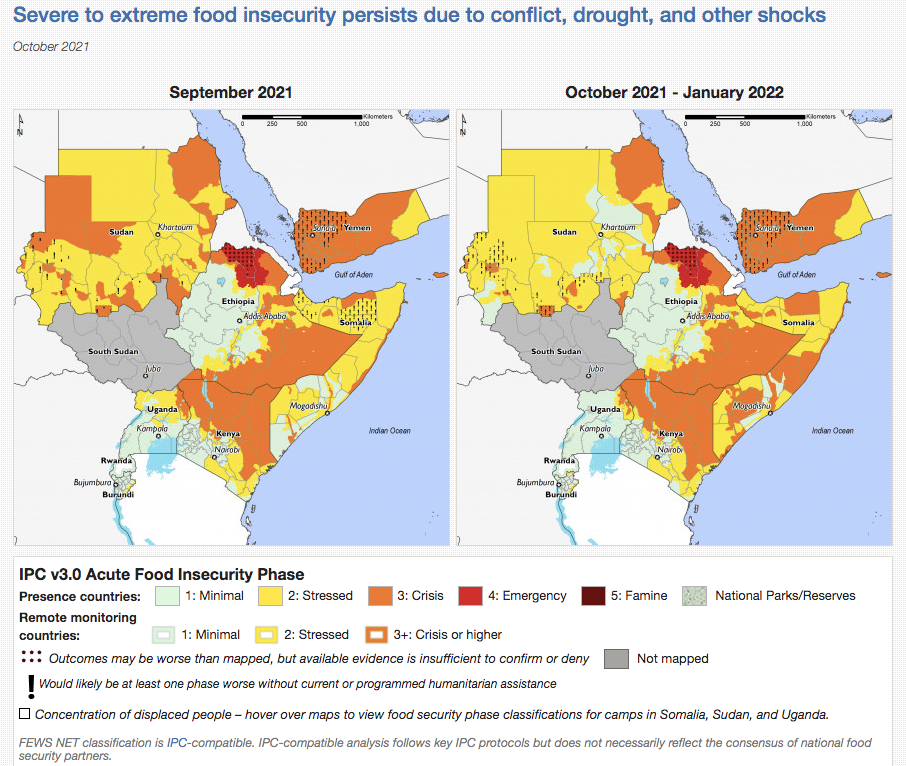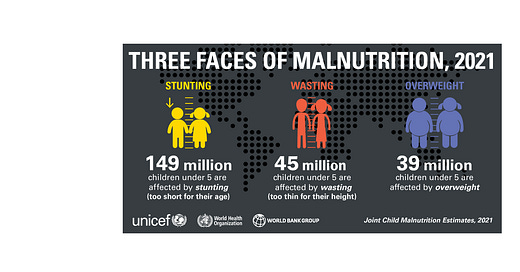Malnutrition in African Countries
2021 and 2022 have to be the Nutrition years of Action if we want to reverse the trend.
24th November 2021
In 2021, the covid-19 pandemic, extreme weather, droughts, conflict, and economic challenges, are causing hunger to increase at an alarming rate in Africa. To understand how we can act, it is important to understand what is malnutrition, its challenges and how we can slowly, together, try to lower the rate.
What is malnutrition?
Food is necessary to human’s survival, and it must be consumed regularly and ought to be nutritionally sufficient. Nutrition, which encompasses the core of feeding, is the science that analyzes food’s interaction with nutrients, food additives, bio-available secondary metabolites to provide maintenance, health, development, and fortification to a living organism (Oladipo & Ogunsona, 2020).
On the other hand, the concept of malnutrition refers to an inadequate diet, deficiencies, excesses, or imbalances in the intake of energy and/ or nutrients. (International Food Policy Research Institute, 2016).
Malnutrition can be physically manifested in the range of stunting, wasting and overweight. However, malnutrition is not only about lack of food, but instead is a combination of other causes that lead to malnutrition in children, including diet at home, illnesses such as malaria and water-borne diseases, limited access to clean water and sanitation infrastructure, about knowledge safe hygiene practices, lack of access to health services, and inadequate feeding practices (UNICEF, 2021).
In addition, malnutrition can lead to dire consequences that can affect life expectancy, economic growth, education, development, and several other domains of physical, social, and mental health (Victora et al., 2008).
Malnutrition: a global challenge
Therefore, malnutrition is a global challenge that continues to be a major factor to determine child health and human survival in low and middle-income countries (Potami & Nandy, 2020). Multiple factors including environmental challenges such as land and crop degradation, periodic droughts and weather-related shocks, and a variety of social disparities such as poverty, limited access to basic food staples and essential services, and population growth, can contribute significantly to emergency levels of malnutrition in developing countries (UNICEF, 2021). Historically, malnutrition has been related to different population sub-groups, and the divide has mostly been by socio-economic status; undernutrition was linked to resource-poor populations, while overweight and obesity were associated with the affluent (Sheets, Tang & Woldu, 2019).
Malnutrition in Africa
One of the major problems common to African countries is the scarcity of food availability, drinkable water, and malnutrition. This is a result of multiple social and environmental factors like armed conflict, oil spillage, price inflation, overpopulation, political instability, financial constraint due to poor governance and mismanagement of funds/resources, lack of health and hygienic services, and climate change conditions, which all these sums up to increment the levels of poverty in the countries.(Oladipo & Ogunsona, 2020).
All these poverty and malnutrition causes may vary across different geographical areas or socio-economic zones in Africa (Oladipo & Ogunsona, 2020). For instance, malnutrition contributes substantially to childhood mortality and morbidity in South African countries. Indeed, South African countries are notable for one of the worst cases of children malnutrition, low level of birth weight, and underweight (Yaya, et al., 2020). The state of malnutrition in Africa is alarming and requires urgent policies and programs to alleviate the scourge.
30.4 million people are currently facing severe food insecurity, which is slightly above the same period in 2020 but a decrease from 33.3 million in March 2021, the latter due to seasonality. This is in addition to 15.7 million at the risk of food insecurity in urban areas. (East Africa Regional Food Security & Nutrition Update (August 2021) WFP)

How can we address Malnutrition?
It is now the time for bold and collective actions. With the Elon Musk vs David Beasley WFP Twitter exchange, we saw that the emergency cannot be ignored by anyone anymore but also how support should come from local organizations as well that can be more impact/action-driven, transparent and accountable.


The COP 26 ended after 2 weeks of negotiations and in the COP 26 text that was released post-event, there is no mention of Food security, agriculture, or farming.
What we can do is address issues of malnutrition through engaging the local communities, organizations, individuals, connecting them worldwide to share ideas and solutions towards solving issues of malnutrition and environmental concerns. GlocAllia
GlocAllia is launching its first innovation program focusing on Food Systems. We aim to co-create together respecting our differences and using them to co-design a system that can fit well with the people without distorting the long-term traditional food production system but using different methods while addressing the existing malnutrition and ecological challenges. You can apply or find more information here.
Malnutrition is growing quickly, and we ought to also act quickly because the solutions are in our hands right where we are, the green world has all the tools needed to address the socio-ecological problems from its very roots and create a better world for this generation and generations to come. GloCal Community gives all individuals and communities an opportunity to accelerate their solutions to be of impact to those around you and beyond the boundaries of one country because we know that one solution can be used differently in different areas. We can co-create as one big global community to solve more problems with different solutions in the different communities for a better sustainable planet.
REFERENCES
Black, R.E., Victora, C.G., Walker, S.P., et al. (2013). Maternal and child undernutrition and overweight in low-income and middle-income countries. Lancet. 382:427–51.
International Food Policy Research Institute (2016). Global Nutrition Report 2016 From Promise to Impact Ending Malnutrition by 2030. DOI:10.2499/9780896295841.
Oladipo, I. C., Ogunsona, S. B., & Oladipo, I. C. (2020). BIOAUGMENTATION: THE WAY OUT OF MALNUTRITION IN AFRICA. European Journal of Advanced Research in Biological and Life Sciences Vol, 8(1).
Pomati, M., Nandy, S. Assessing Progress towards SDG2: Trends and Patterns of Multiple Malnutrition in Young Children under 5 in West and Central Africa. Child Ind Res 13, 1847–1873 (2020). https://doi.org/10.1007/s12187-019-09671-1
Sheets, L.R., Tang, C.Y. & Woldu, H.G. (2019). The paradox of female obesity in low and lower-middle income countries. medRxiv 19003004.
UNICEF (2021). Malnutrition. A major cause of death in children. Retrieved in November 2021. Web site: https://www.unicef.org/wca/malnutrition
Victora, C. G., Adair, L., Fall, C., Hallal, P. C., Martorell, R., Richter, L., ... & Maternal and Child Undernutrition Study Group. (2008). Maternal and child undernutrition: consequences for adult health and human capital. The Lancet, 371(9609), 340-357.
UNICEF-WHO-WB (2021). The UNICEF-WHO-WB Joint Child Malnutrition Estimates (JME) group released new data for 2021. Web site: https://www.who.int/news/item/06-05-2021-the-unicef-who-wb-joint-child-malnutrition-estimates-group-released-new-data-for-2021
Yaya, S., Odusina, E.K., Uthman, O.A. et al. (2020). What does women’s empowerment have to do with malnutrition in Sub-Saharan Africa? Evidence from demographic and health surveys from 30 countries. glob health res policy 5, 1. https://doi.org/10.1186/s41256-019-0129-8
Severe to extreme food insecurity persists due to conflict, drought, and other shocks by FEWS https://fews.net/east-africa
WFP, Regional Food Security & Nutrition Update Regional Bureau Nairobi, August 2021 Regional Food Security & Nutrition Update
If you have any questions, you can contact us here.






